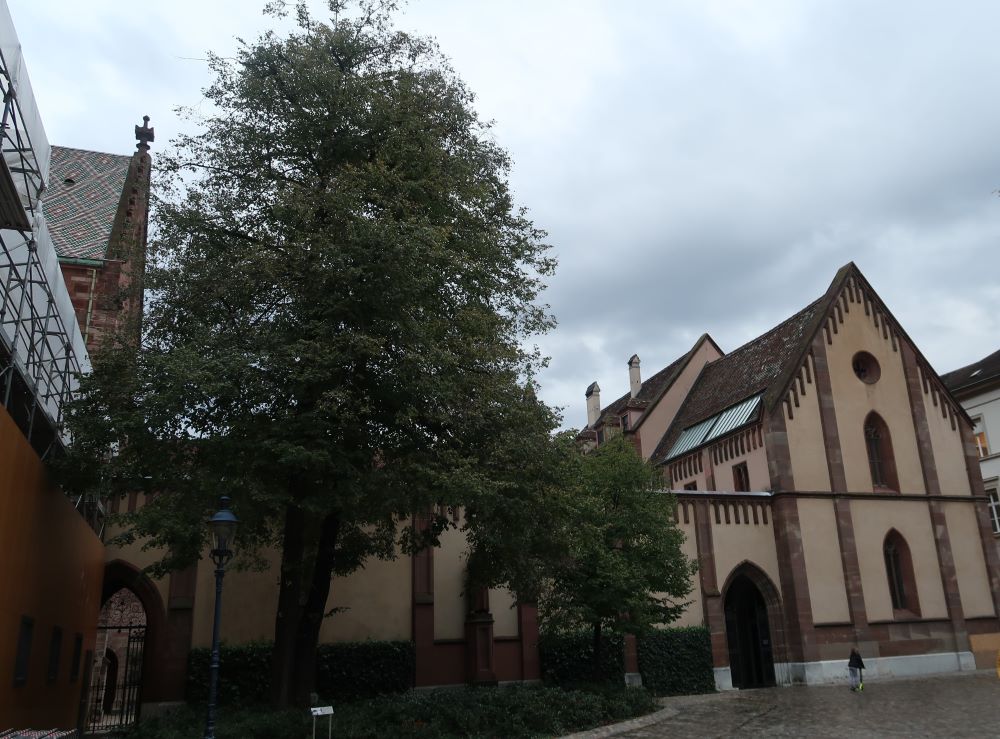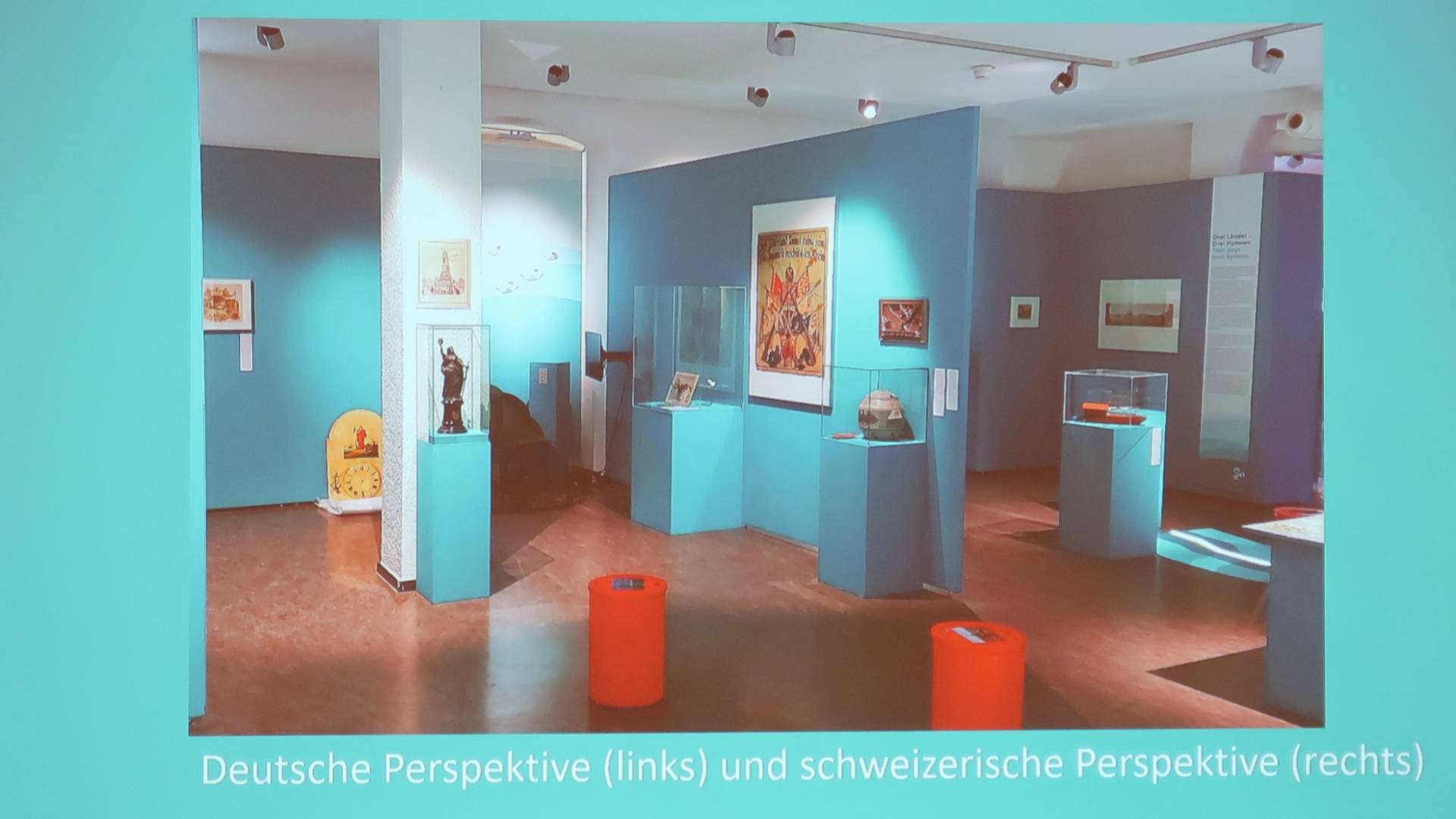The Rhine in 38 Exhibitions
15 November 2022
The Three Countries Museum (Dreiländermuseum) in Lörrach opened its series of 38 cross-border exhibitions on the theme of the Rhine on 11 November with a vernissage in the Evangelische Stadtkirche.

Vernissage, the choir with French, German and Swiss songs from the nineteenth century.
On 12 November, the annual meeting of the network of historical societies on the Upper Rhine (Netzwerk Geschichtsvereine/Réseau des Sociétés d’Histoire) took place at the Dreiländermuseum. Over 200 historical societies are a member of this network.

Speakers and organisers of the colloquium (‘the Rhine’) of the network of historical societies on the Upper Rhine, 12 November 2022
The exhibition is the result of the cooperation of the network of museums (Netzwerk Museen/Réseau des Musées) on the Upper Rhine. This network is the largest cross-border project of museums in Europe coordinated by the Drieländer Museum.
As its name already suggests, the Three Countries Museum focuses on the shared history of France, Germany, and Switzerland. The museum lives up to its name and more than that.
It is an example of concrete and practical regional cross-border cooperation. The Three Countries Museum and the network of museums organise a major trinational exhibition every four.
The Rhine


Basel and the Mittlere Brücke 2022 (top) and sixteenth century (bottom, after a woodcut by Johannes Stumpf or Sebastian Münster). Collection: Dreiländermuseum (DLM K 16-233).

The Albert and Hélène Schweitzer-Bresslau tree at the Münsterplatz in Basel was planted on 24 March 2013. The Linde commemorates the couple’s departure from Alsace to Lambaréné (Gabon) in Africa on 24 March 1913.
The Rhine means emotion and identity. The German-French couple Albert (1875-1965) and Hélène (1879-1957) Schweitzer from Alsace named their daughter Rhena. Basel’s hymn is ‘Z’Basel an mym Rhy‘, (written in 1806 by Johann Peter Hebel, 1760-1826, melody by Franz Abbot, 1819-1885).
Other emotions were less peaceful but nationalistic and focused on territorial expansion. This history goes back to the Celts, Romans, and Germanic tribes.
After the division of the Carolingian Empire at the Treaty of Verdun in 843, the Upper Rhine was, for centuries, until the Reformation (from 1517) and the Peace of Westphalia (1648), an economically, linguistically (Alemannic), religiously (Catholic) and culturally closely linked region. After 1648, It was a war zone between France and Germany until 1945.

Detail of a customs game, showing the dozens of customs posts along the Rhine until 1798. Collection: Drieländermuseum
This agony is also reflected in the perception of the Rhine. France and Alsace commemorate ‘La Grande Guerre’, a day of mourning, on 11 November. Germany has then just passed the ninth of November, and 11 November is a day of reflection. In Basel, however, the sounds of piccolos and tambourines mark the beginning of Fasnacht on 11 November, St. Martins Day!
For France, the Rhine has long been an apparent natural border: the Pyrenees to the south, the Atlantic/North Sea to the west, the Alps to the east, and the Rhine as far as the Netherlands to the north.
Napoleon (1769-1821)implemented this view as well. The Netherlands was part of the French Empire from 1810, the Rhine was the Franco-German border (with the Rheinbund as German satellite states), and he divided Rheinfelden, Kaiserstuhl, and Laufenburg into a German and Swiss part, separated by the Rhine. He respected only Schaffhausen and Klein-Basel on the ‘German’ side of the Rhine as Swiss territory because of centuries-old claims.
Alsace
Alsace was German-speaking and Habsburg territory for centuries until the conquest of Strasbourg in 1681 by Louis XIV (1638-1714). Habsburg renounced its rights to Alsace at the Peace of Westphalia (1648).
However, the German-speaking cities in Alsace (The Zehnstädtebund or Dekapolis) remained linked to the Holy Roman Empire of the German Nation after 1648. Some towns were even connected to the Swiss Eidgenossenschaft! Louis put an end to this through conquests.
The Peace of Nijmegen (1679) definitively ended the aspirations of these German-speaking cities. After the conquest of Strasbourg, Alsace was French territory. The German neighbours did not accept it until 1945.

Left: French poster 1918, view of Strasbourg with the Tricolore from the trenches in the Vosges mountains. Right: German vision of future consequences of French occupation, 1918. Collection: Trinity Museum (DLM PI 1663 and DLM PI 2207).
The conflicts over Alsace in the periods 1840 (the Rhine Crisis), 1871-1918 (German Empire), 1918-1940 (French Republic), and 1940-1945 (German Third Reich) are the climax of this centuries-old conflict.
Die Wacht am Rhein (1840, composed by Max Schneckenberger, 1819-1849) on the German side and the Marseillaise (1792, written in Strasbourg by Claude Rouget de Lisle, 1760-1836) but sung by soldiers from Marseille) on the French side are the most famous belligerent songs of this period. The innocent hymn ‘Z’Basel an mym Rhy‘ symbolizes the difference in perception.

Jean-Jacques Waltz, (Hansi, 1873-1951), Lithographie caricature, 1919, right Breisach (Germany). Collection: Drieländermuseum (DLM GrGeXVIII 83).
The collateral damage was the expulsion of 100 000 Germans from Alsace and Lorraine in 1918/1919 and the banning of the German (Alemannic) language in education after 1918 and 1945. However, German (the Alsacian/Alemannic dialect) was the spoken language until 1918.
Exhibitions and related events
The Rhine is not among the top-ten longest rivers in Europe, but it is the most sailed, sung about, contested, connecting industrialised, mythical, and prestigious river. Its length from its source at Lake Toma near the Oberalp Pass in Switzerland to its mouth in the North Sea is about 1230 kilometres, of which 375 kilometres are in Switzerland.
The Upper Rhine (Oberrhein) flows from Basel to Bingen in Rhineland-Palatinate, and from Schaffhausen to Basel, it has the name High Rhine (Hochrhine). The exhibition covers this area.
The unique series of 38 exhibitions discusses a wide variety of topics. They will not be discussed here. The museums’ websites provide excellent information. With two exceptions. The already discussed exhibition ‘Ave Caesar! Römer, Gallier und Germanen am Rhein‘ and the exhibition (Der Rhein. Die Überblicksausstellung/Le Rhin. L’exposition générale) at the Dreilländermuseum.
The retrospective exhibition and events
The Rhine flows through the museum, including a half-hour cruise in a comfortable boat from the Mittlere Brücke in Basel to the Dreiländerbrücke.

The Dreiländerbrücke. Photo: Michael Sesiani

Well-chosen objects, documents, topographical maps, videos, and audiovisual presentations illustrate or present various topics. The museum’s impressive collection is also reflected in the fact that only its collection has been used.
The French, German, Swiss, and European perspectives are the beginning and starting point of this cultural-historical journey along the Rhine, with sensitivity and respect for detail, without losing sight of the big picture.

One part of the exhibition shows the construction of forts along the Rhine, with particular attention to Sébastien de Vauban (1633-1707) during Louis XIV and the structure of the Maginot Line after 1918 on the French side and the German forts of 1871-1918 and the Westwall of 1940-1945 on the German side. Attention to the irreconcilable Treaty of Versailles (1918-1919) and the other conciliatory approach after 1945 conclude the period 1870-1945.

Hydropower Kembs (1932). The Treaty of Versailles gave France back the Rhine as a border and all rights to use the Rhine. Collection: Drieländermuseum (DLM FoD 2)

Eduard Tennner (1830-1901), Der Isteiner Klozt, 1882, Rhine romanticism. Collection: Drieländermuseum (DLM BKVer 25)
Numerous other topics pass are being dealt with: geology, gold mining, religions and church building (from Chur to Utrecht, the Rhine was a ribbon of Romanesque and Gothic cathedrals), fishing, Rhine regulation, shipping, hydropower plants, canalisation, pollution, floods, art, literature and music, Rhine romanticism, archaeology, (Alemannic) dialects, bridges over the Rhine and various other topics. What is the Rhine without wine? That, too, has been thought of.

The museum also organises dozens of lectures, conferences, concerts, excursions, children’s programmes, and other events on these topics.
(Source and further information: Drieländermuseum in Lörrach)



Neuenburg am Rhein, the Rhine



